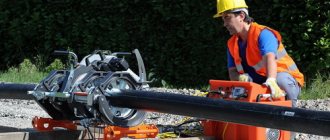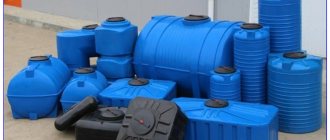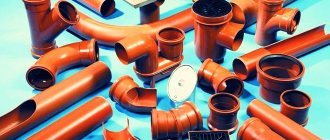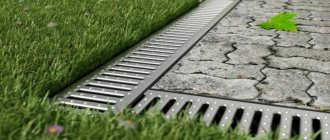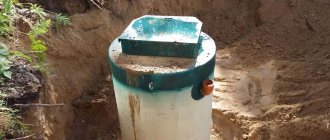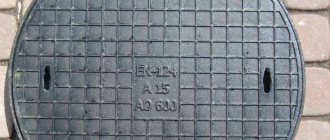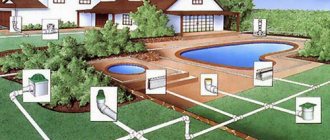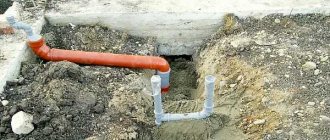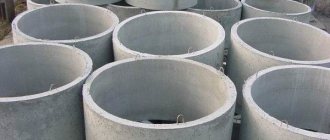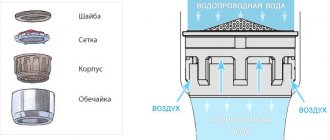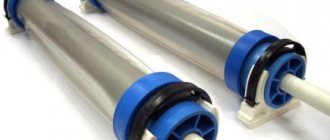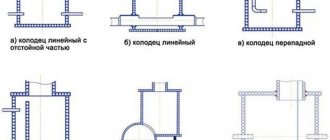Plastic pipes for sewerage
Advantages:
- Resistance to chemical reactions. Since sewer pipes are constantly exposed to numerous chemical influences, they are protected from destruction. Plastic is not destroyed by chemical reactions;
- External damage. Since the external sewer is placed in the ground, it is affected by the soil. The structure of the plastic can withstand severe loads, mechanical damage and pressure;
- Resistance to clogging;
- Installing a sewer drain takes half as much time as creating a sewer system from metal products. They are connected to each other without welding - they are inserted into each other using a special lubricant;
- Price. Compared to other materials, plastic is much more profitable.
To install plastic sewerage, you will need tees and fittings. Most often this is necessary when creating an internal sewage system at home.
Choosing the correct sewer diameter. For individual construction (private house), a diameter of up to 150 mm is sufficient, even for a house with 4-5 bathrooms.
Larger diameter material is used for sewerage in hotels, hospitals and other administrative institutions. Diameters greater than 300 mm are used in industrial enterprises.
Universal type for sewerage – polypropylene models (PP index). They combine favorable cost, service life of up to 50 years and easy installation. PP is used in the construction of private houses in the distribution of external and internal sewerage systems.
Marking of PVC pipes
Based on external features, it can be difficult to distinguish different types of polymer pipes from each other. In accordance with standards, manufacturers carry out labeling containing all the information necessary to identify products. As an example, we can consider one of the common and affordable types - polyvinyl chloride (PVC, or PVC). These products are used in water supply, heating, sewerage networks, and when laying electrical wiring.
Russian manufacturers produce them according to 2 standards - for water supply and heating systems in accordance with GOST R 52134-2003, for internal sewage systems in accordance with GOST 32412-2013.
In the first case, the designation contains the word “pipe”, the material designation indicating ten times the tensile strength MRS, the standard dimensional ratio SDR (the ratio of the nominal outer diameter to the nominal wall thickness), the nominal values of the outer diameter and wall thickness, the service class, the nominal pressure and standard number. The labeling may be supplemented with the inscription “drinkable” if this requirement is met.
An example of a symbol for a pipe made of unplasticized polyvinyl chloride with minimum long-term strength MRS = 12.5 MPa, SDR 21, nominal outer diameter 140 mm, nominal wall thickness 6.5 mm, service class 1, maximum operating pressure 1.0 MPa.
PVC-U pipe 125 SDR21 - 140´6.5 class 1/1.0 MPa GOST R 52134-2003.
In the second case, the designation includes the designation of the material, nominal values of the outer diameter and wall thickness, and standard number.
An example of a symbol for a polyvinyl chloride pipe for internal sewage systems with a nominal outer diameter of 160 mm, a nominal wall thickness of 3.2 mm.
PVC-U pipe (PVC-U) 160´3.2 GOST R 32412-2013.
Labeling of imported products is carried out in accordance with the requirements of European and international standards. Compliance of the specified technical characteristics with the necessary requirements should be checked either according to the standard or according to the certificate of conformity.
In addition to technical characteristics, manufacturers additionally apply their logo and production date. The marking is applied in 1 m increments in a manner that ensures its preservation for the entire declared service life.
Corrugated plastic pipes
A common material for sewer construction. Due to their structure and properties, they perform well underground. In addition to sewerage, they are used in electrical wiring.
Kinds:
- Single layer. Used in cable ducts, protection of power lines;
- Double layer. They are used in sewers and underground for communications due to their increased strength;
- Lungs. Vulnerable to mechanical stress, therefore not used underground;
- Heavy. Average stability opens access to use for underground communications;
- Super heavy. They are used for laying communications in difficult conditions (under a highway).
Based on the material they are divided into:
- Plastic;
- PVC;
- HDPE.
Durable and will last up to 50 years. The plastic is resistant to temperature overloads - can withstand heating up to 95 degrees Celsius. They are not subject to chemical reactions, so they are used in contaminated soil. PVC is much more popular than polypropylene in creating sewer systems, especially internal ones.
HDPE is the lightest and most versatile material of the three presented. They can withstand all soil loads and are not subject to corrosion or exposure to ultraviolet rays.
Differences from smooth types:
- Notches over the entire area and length of the material;
- Due to them, a high level of flexibility and practicality is achieved;
- Double layer structure;
- Installation without the use of additional means (fittings, couplings);
- Mobility involves use in conditions of ground changes;
- Lightness increases versatility of use and ease of installation.
Types and characteristics
To assemble heating systems, you can use the following types of plastic pipes:
- Polypropylene.
- Made from cross-linked polyethylene.
- Metal-plastic products.
Polypropylene
For the installation of heating systems, polypropylene pipes are the most budget option. However, they have a high coefficient of linear expansion, which is why pipelines assembled from PP pipes can bend and sag during operation, which negatively affects the performance and aesthetics of the external appearance of the system. Therefore, this type requires a larger number of fasteners during installation.
There are three types of polypropylene pipe products according to the degree of heat resistance:
- Homopolypropylene (PP-N). PP-N pipes are characterized by high strength, chemical inertness, but are unstable to high temperatures. They are used when laying water pipes, ventilation ducts, drainage pipelines, etc.
- Polypropylene block copolymer (PP-2). Products made from PP-2 are intended for low-temperature heating systems, as they are resistant to temperature loads not exceeding +50 ºС. They are mainly used for installing heated floors and hot water supply pipelines.
- Random copolymer PP-3. The material is obtained by introducing ethylene units into the molecules of the main polymer. PP-3 pipes are characterized by increased flexibility, impact resistance, and high resistance to thermal loads. This is the most suitable option for arranging heating wiring from the boiler to the radiators.
The main technical characteristics for polypropylene pipes PP-3 are given in the table.
| Indicator name | Meaning |
| Limit temperature of the working environment during long-term operation | +70 ºС |
| Critical pressure level at maximum temperatures | no more than 10 atmospheres |
| Peak short-term permissible temperature | +90 ºС |
| Operating pressure at media temperature 25 ºС | up to 25 atmospheres |
| Linear expansion coefficient | 0.17 mm/m*ºС |
| Oxygen diffusion rate per day | 900 mg/m² |
Made from cross-linked polyethylene
PEX brand cross-linked polyethylene is a special type of polymer with a modified molecular bond structure. It is based on ethylene polymerized under high or low pressure. Cross-linking significantly improves polyethylene properties such as heat resistance, flexibility, wear resistance and the ability to self-heal after mechanical stress. Therefore, pipes made from cross-linked polyethylene are excellent for heating.
The technical characteristics of polyethylene pipes are as follows:
- Density - 940 kg/m3.
- Low coefficient of linear expansion.
- The maximum operating temperature is 95 ºС.
- Melting point - 200 ºС.
- Peak temperature load (short-term) - 130 ºС.
- Operating pressure parameters at:
- 20 ºС - 2.3 MPa.
- 95 ºС - 0.8 MPa.
Metal-plastic
The wall of metal-plastic products consists of five layers:
- Internal plastic smooth surface, which during operation is in direct contact with the coolant.
- Adhesive layer.
- A barrier layer made of aluminum foil, which increases the strength and durability of pipelines, and also reduces the degree of thermal expansion of products.
- Another layer of special glue.
- Polymer protective layer.
Due to the multilayer wall structure, high mechanical strength of the pipes is ensured, the sound insulation effect is enhanced, and thermal conductivity is reduced. This type of plastic pipe has the following performance characteristics:
- The maximum operating temperature is 95 ºС.
- The maximum temperature (for short-term exposure) is 130 ºС.
- The maximum pressure level at 95 ºС should be 10 bar; at a media temperature of 0 to 25 °С, it should not exceed 25 bar.
- Service life is at least 15–20 years.
Plastic pipes for heating
Heating made from steel and cast iron products is a thing of the past. Due to the complexity of installation, connection and high cost, these materials turned out to be unprofitable. They were replaced by polypropylene. For heating systems, it is recommended to use polypropylene with reinforcement. This increases service life.
Reinforcement is divided into fiberglass and aluminum. In the first option, the reinforcement is inside the product, in the second, aluminum envelops the outside.
Fiberglass prevents deformation under the influence of temperature changes and extreme heat. The cost is 30-40% higher than material without reinforcement. You shouldn't skimp on this. Reinforced ones guarantee the durability of the heating system.
Advantages of plastic pipes for heating:
- Service life – up to 50 years. The correct selection of material will allow you to forget about replacing and repairing the heating system for a long time;
- Resistance to chemical processes. Plastic bypasses steel and cast iron because it is absolutely not susceptible to rust;
- Since plastic is a soft material, the flow of water inside will not disturb residents with its noise;
- Easy to connect. To install heating, you only need a special welding machine, which is often called a soldering iron. The skills of welding plastic models are acquired literally in 5 minutes or in 2-3 parts welded together;
- When water freezes, you don’t have to worry about the safety of reinforced plastic;
- Low cost. Polypropylene for heating is half the price of metal ones.
Disadvantages of plastic pipes for heating:
- The wrong choice leads to replacement of the heating system;
- Fire hazard. Heating made from plastic pipes is vulnerable to fire.
When purchasing, the following is taken into account:
- Pressure. Indicated next to the main marking. For example, PN25 is a polypropylene pipe that can withstand a pressure of 25 atmospheres. Suitable for most heating systems;
- Temperature. There are two types of markings. The first is an indication of the maximum temperature. Usually it is 90 degrees Celsius. The second - the use for hot and cold water is marked with the hot&cold;
- Reinforcement. As mentioned above, this is one of the main selection factors. It is advisable to choose options with fiberglass reinforcement;
- Diameter. This item depends on the room in which heating is used. In private houses, a diameter of 32 to 40 mm is used for wiring. When inserting into the radiator, 20 or 26 mm options are used.
Plastic pipes for water supply
In the area of plumbing, plastic has replaced other materials. In old apartment buildings, owners have long been replacing the old metal plumbing system with a practical plastic one.
Advantages of plastic pipes for water supply:
- Price. Plastic options are much cheaper than steel ones;
- Environmentally friendly. One of the deciding factors. Since they are used to carry water into the bathroom, to the sink, they should not affect the level of contamination and composition of the water. What can't be said about metal;
- Resistant to corrosion and other chemical reactions . Metal parts are subject to rust, but plastic parts are not. Because of this, water does not come into contact with harmful particles and substances. Relatively clean water comes from the tap. But still, this does not exempt you from installing a water filter and does not guarantee perfectly clean water;
- Easy to install. Like the heating options, water supply systems can be installed in a matter of minutes without the use of complex additional equipment other than a welding machine;
- Resistant to sudden temperature changes. When water freezes, the pipe will not crack or burst. Also, when heated to high temperatures, the material will not deform or swell;
- A service life of up to 50 years will allow you not to worry about replacement or repair for many years.
The only disadvantage is that plastic for water supply cannot be used in fire hazardous conditions.
Features that you need to pay attention to when choosing:
- Maximum heating temperature. Indicated next to the marking;
- Maximum pressure;
- Manufacturer. The design and composition features depend on it.
When installing inside the house, you will need metal taps and adapters. All bends and angles can be made using special fittings and corners, which are also made of plastic. After welding all the parts together, you must immediately check the strength and absence of holes in the joints.
If the plumbing does not involve the use of hot water, you can use ordinary plastic materials. To conduct both hot and cold water, a different material is needed.
Advantages and disadvantages of plastic water pipes
The main advantage of plastic is its durability. Unlike metal structures, plastic pipes are more resistant to external factors. They do not corrode, and salt and other deposits do not form on the pipe walls. Since plastic pipes have come into use relatively recently, it is difficult to determine their exact service life. Manufacturers declare the service life of a plastic water pipe to be at least 50 years, subject to proper installation and operation.
The latest models of plastic pipes for water supply are made from organically pure material that does not have a negative impact on the environment. They do not degrade water quality. Due to the low thermal conductivity of plastic, such plastic pipes used in heating systems and hot water supply systems help retain the heat of hot water. It is also noted that the density of the walls of such pipes tends to suppress the noise of the water flow.
The only disadvantage of plastic water pipes is that not all types are suitable for the efficient operation of a hot main. But taking into account the fact that the industry does not stand still, there are already plastic products on the market that can withstand temperatures of about 90 degrees. Therefore, when planning to install plumbing, you just need to find out which pipes are suitable for solving your particular problem.
Plastic pipes are great for those who want durable, easy to install and practical plumbing. Their service life significantly exceeds the warranty period of metal pipes, and installation can be carried out even at home without special training.
Plastic pipes for hot water
Conducting hot water is more common in residential areas and bathrooms. For other purposes, ordinary plastic pipes are used for plumbing. The synthetic composition of the polypropylene pipe allows it to be heated up to 140 degrees Celsius. In this case, the shape of the product will be restored after complete cooling to operating temperature.
For hot water supply, reinforced polypropylene models will be required. Reinforcement is the introduction of a metal lattice or cladding into the structure of a plastic pipe. It comes in two types - aluminum or fiberglass reinforcement. The first option is used less frequently. Reinforcement with a layer of fiberglass increases the durability of the material.
Advantages of plastic pipes for hot water:
- Increased heat resistance. Therefore, they are used to conduct hot water;
- Resistant to temperature changes. Reinforced ones can easily tolerate both cold and hot water. When heated strongly, the structure of the material and the product itself are not deformed.
Products with aluminum reinforcement or a layer of foil are also used. If reinforcement occurs internally, water reacts with the metal. This material is inferior in properties to fiberglass.
Structure: inner layer of polypropylene, middle layer of fiber, outer layer of polypropylene. Plastic is an environmentally friendly and versatile material, and the fiber mesh adds strength and stability.
When choosing, you need to focus on the diameter of the riser - from 19 to 26 mm. When wiring from the riser to floors, a much smaller diameter is used (half the size) - about 12-13 mm. When choosing a diameter, it is necessary to take into account the length of the water pipe, the number of floors and the expected water flow.
It is not recommended to save on hot water supply. When using materials of questionable quality, accidents and flooding occur. After this, you will have to buy the material again and do all the work.
Polypropylene is a flexible and light-alloy material. This causes problems when heating. Polypropylene greatly expands and deforms if the water in it reaches a temperature higher than stated on the label. When the temperature rises to 175 degrees Celsius, the material will melt.
The operating temperature is approximately 90 degrees. At high pressure and temperature, the material may burst. In addition, the pipe expands in length. It is undesirable to use polypropylene for floor insulation. The decorative coating (for example, tiles) will begin to crack due to the expansion of the pipes.
For this reason, reinforced polypropylene appeared. It does not cancel all the disadvantages of the material, but makes it much more practical. Reinforcement prevents the plastic from expanding, deforming and melting.
Types of reinforcement:
- Aluminum. Divided into subspecies. A reinforced layer of aluminum foil on the outside, inside or in the middle of the product. The type can only be determined by the cut.
Aluminum foil can be up to 0.5 mm thick. It is connected to the plastic using glue. The quality of the material is tested by time - pipes often delaminate and come apart under the influence of hot water and daily use. Saving and buying cheap and little-known brands is inappropriate in this case;
- Fiberglass is an alternative to aluminum. The fiberglass layer is a mixture of polypropylene and fiber fibers. This layer is welded to the outer and inner layers, so the structure forms a single whole. The material's margin of strength and resistance to deformation is higher than that of aluminum, and the price remains the same.
Installation of reinforced products is no different from conventional plastic ones. A welding machine or soldering iron is used. For corner connections, fittings and couplings are used.
The process is different for pipes with aluminum reinforcement. Before using the soldering iron, the top layer of metal is cleaned. If the foil is located in the inner layer, you will need a trimmer. The procedure is necessary to prevent delamination and unsticking of the material.
Polyvinyl chloride (PVC) pipes
The material was one of the first to be used for the manufacture of pipes, due to its low price, good mechanical properties and resistance to the external environment. In terms of areas of application, PVC pipes are superior to other types, including when laying cold water and sewerage pipelines. At temperatures above 65°C they soften and then melt. Additives to plastic can change its performance properties. For hot water, chlorinated PVC is better suited, which can be used for installing heating systems.
Installation of plastic pipelines is carried out using welding or fittings. Unlike other materials, PVC products can also be glued with special plumbing glue.
PVC pipes are manufactured as non-pressure pipes (with sockets), pressure pipes and for gas supply. For sewerage in city apartments, the first type is used, and in water supply systems - the second, which can withstand pressure from 6 to 16 atm.
Among the disadvantages, one can note a decrease in plastic properties at low temperatures, which requires the installation of thermal insulation for external laying and care during installation due to the formation of chips and scratches.
Plastic pipes for heated floors
The water in such a system is heated to a temperature not exceeding 40 degrees Celsius and is distributed evenly. Most often, heated floors are installed in bathrooms and kitchens.
Types used for installation:
- Metal-plastic;
- Polypropylene;
- Polyethylene.
Metal-plastic is a cheap and alternative option to copper. The inner layer is made of polyethylene, the middle layer is made of aluminum, and the outer layer is made of polyethylene.
Polypropylene is cheaper than the previous option. But it is rarely used, since its safety margin and resistance to overheating are much lower. The best solution was cross-linked polyethylene. It is characterized by increased strength, durability and resistance to overheating. The price for the material is reasonable.
Laying heated floors is a complex process with long preparation. Before laying, a plan is drawn up. A diagram is drawn on paper, which is followed during installation.
Placed in a snake or spiral pattern. The first option is fast, but not uniform. The floor is heated by fragments. The second method is more common. The spiral heats the floor area evenly.
The distance between the heating tubes is up to 35 centimeters. According to statistics, a pipe with a diameter of 16 mm heats 15 cm on each side of itself over its total length.
The next stage is cleaning the floor and leveling it. After this, the laying of the plastic pipe begins according to a pre-designed scheme. The first step is to lay the underlay over the area of the room. On top is a layer of foil. Next, the reinforcing mesh is laid. The grid cells are no more than 10 by 10 cm in area.
The plastic pipe is laid according to the drawn up diagram and fastened in increments of 40 cm. The places where the heating comes out of the floor screed are first covered with a protective casing. This will prevent deformation and abrasion of the plastic when pouring the top layer of screed and further use.
Before pouring the concrete screed, the system is connected to the collector and the possibility of leaks is checked. The thickness of the screed layer is no more than 7 cm, otherwise the floor will not warm up.
It is important to approach the choice of material for heated floors responsibly. Otherwise, there is no point in spending money on external floor finishing - at any moment, low-quality plastic can burst, swell or deform so that all the floor tiles crack and split. After this, you will have to start all the work from scratch.
It is better to spend more money on quality materials one time than to redo the entire structure and system.
Fast and high-quality assembly of water pipes from plastic pipes
To get a high-quality plumbing system, you need to correctly follow the work technology. Laying begins from the connection point to the water consumption device. An adapter with a ball valve is installed here, with which you can turn off the water.
The pipe is attached to the wall with special holders, 20 mm away from it. The holders are installed with a maximum step of 1.5 m; be sure to install the mount at bends and at turns. Fittings are used for turns and corners.
Before connecting the internal water supply network to utility systems, it is necessary to install shut-off valves to turn off the water supply. A counter is also installed here.
High pressure plastic pipes
They are characterized by increased strength and adaptability to overloads. Mainly used for transporting liquids in oil plants, mechanical engineering, and hydraulic systems. Three-layer structure. The middle layer is most often a reinforced mesh.
LDPE includes polyethylene as the main component. Products made from it are completely environmentally friendly. LDPE with a diameter of 16, 25 and 32 millimeters are common.
Advantages of high pressure plastic pipes:
- Low thermal conductivity. Due to this, the transportation of liquid became possible with virtually no loss of temperature. This property also reduces the level of condensation;
- Resistance to frost allows the use of TPVD even in the most unfavorable conditions. When the water inside freezes, the outer shell does not collapse or deform. Due to this, the need for repair work and restoration is eliminated;
- Easy installation due to the weight of the product. Steel pipes weigh 6 times more than HDPE;
- Elasticity allows the material to withstand all mechanical stress and shock;
- Environmental friendliness;
- Service life – up to 50 years;
- Silence of water flow.
Disadvantages of high pressure plastic pipes:
- This material is not suitable for creating a fire-resistant water supply system;
- Maintaining temperature conditions. Although the material can withstand overloads, it melts when the temperature rises too high;
- Fear of light rays. Therefore, TPVD is coated with additional insulation against ultraviolet rays;
- Fastening methods and technologies differ from others.
Characteristics of high pressure plastic pipes:
- Pressure. The indicator is determined by the brand of polyethylene, wall thickness, and diameter of the product;
- Working temperature. The temperature standard at which the product retains its properties and performs its functions is +40 degrees Celsius. If the standards are exceeded, it is inappropriate to talk about maintaining the working condition;
- Diameter. The diameter range is from 10 mm to 3000 mm. For water supply in private and apartment buildings, a diameter of 20 mm is used;
- Wall thickness. The parameter varies from 2 to 6 millimeters. This point directly depends on the diameter of the product.
Two methods are used for installation - compression or electric welded fittings . The first method is faster and easier. It does not require special skills or equipment. In most cases, it is used at home to connect two sections.
The second method is electric welded fittings. The fitting is combined with an internal spiral, which is melted using special equipment and connected to another part. After the material hardens, both parts become one. This method is much more reliable and durable. But this requires experience and equipment. For private purposes, this method is rarely used.
TPVD is one of the most reliable. The scope is very diverse. The material is unpretentious. The only thing required to protect it is insulation from ultraviolet rays.
Metal-plastic pipes
The multilayer structure of pipes based on cross-linked polyethylene with a layer of aluminum or copper foil inside allows the products to achieve high strength. Each layer is glued to the neighboring one. The product becomes flexible like plastic, but at the same time acquires the strength of metal. Metal-plastic pipes differ from ordinary pipes in that they retain their shape when bent and can withstand greater fluid pressure. They are well suited for hot water supply systems, but are slightly deformed during thermal fluctuations.
Installation of metal-plastic is done using threaded fittings.
Frost-resistant plastic pipes
Plastic, as an extremely vulnerable material, without additional involvement in the composition and structure, is not suitable for use in adverse conditions. For use in frosty weather or underground, frost-resistant options are used. They are required when creating sewerage systems, protection for electrical networks, and water supply.
Frost-resistant material is used when transporting liquids over long distances and for heat-conducting lines.
Advantages of frost-resistant plastic pipes:
- Price. The price of plastic is lower than that of metal;
- Increased resistance to external influences;
- Operation at particularly low temperatures. For these purposes, metal-plastic products are often used, the stability of which remains up to -400 degrees Celsius. When the water inside freezes, the material itself will not lose its properties. After thawing, the plastic will return to its original shape.
The material has virtually no disadvantages. It is superior to metal and steel products in all respects.
Disadvantages of polymer pipes
The disadvantages of similar products include:
- In order for products such as those intended for drainage, they are not always suitable for the construction of fire extinguishing systems;
- The use of similar products in creating a pipeline for transporting warm water is limited;
- Installation technology for different types of polymers may have differences that you should be aware of.
Note! These parameters refer more to the advantages of a similar type of pipe than to their disadvantages. This phenomenon is explained by the fact that the standard for pipeline installation is steel pipes, and all others, including plastic pipes, have inconsistencies with them. Such inconsistencies are considered by experts as shortcomings.
Gas plastic pipes
Polyethylene gas pipes are painted black with a yellow stripe to distinguish them from all others.
Advantages of gas plastic pipes:
- Frost resistance. Copes even with low temperatures;
- Immunity to corrosion, which allows use in underground conditions;
- Resistance to mechanical stress guarantees calm resistance to soil influences;
- Service life up to 50 years;
- Weak gas permeability. Gas is not allowed to pass through the walls due to the use of polyethylene, which is much stronger in structure than polypropylene;
- Ease of installation. Laying a gas pipeline from plastic is much faster than from metal;
- No additional chemical protection, casings or linings are required. Copes with all overloads and difficulties without additional protection;
- Cheaper than metal ones;
- There is no need for waterproofing. This further reduces the cost of material and installation work in general.
With their help, a gas pipeline is laid only underground. Use in residential buildings and on surfaces is prohibited due to vulnerability to external influences. This reduces security.
Not every type is used for gas transmission. Material of the first and second categories is not suitable for use in difficult conditions (under passages, highways). It is also prohibited to use in areas with increased seismic activity.
Gas polyethylene pipes exist in two types: PE-100 and PE-80. They differ in wall thickness. The first version of PE-100 has a thickness of 3.5 millimeters. Pe-80 - from 2 to 3 millimeters. Also, both types differ in the pressure they can withstand. The first type can withstand up to 12 atmospheres, and the second - up to 6 atmospheres.
Operating temperature ranges from -15 to +40 degrees Celsius. If the temperature exceeds the upper threshold, the product loses its properties and deformation begins.
A polyethylene gas pipeline is more difficult to connect than a water supply or sewer system. For this purpose, special tees, couplings, plugs and reductions are used. For connection, either butt welding or compression connection is used.
Today there is no alternative to polyethylene pipes for gas pipelines. Metal gas pipelines for underground routes are a thing of the past, and polypropylene products do not have a set of properties for safe use in gas pipeline construction.
Plastic pipes: material of manufacture, marking, types of pipes for different applications
Under the general name “plastic pipes”, the modern construction market offers a fairly wide range of products that differ in technical characteristics and scope of application. They are distinguished by the polymer material used for manufacturing. On this basis, they are divided into the following types - polyethylene, polypropylene, polyvinyl chloride and metal-plastic based on any of the polymers.
The manufacturer's warranty on plastic pipes is 50 years.
Square plastic pipes
This species is not highly specialized. It differs from the others only in the changed type of section. Before the appearance of square products on the market, round pipes had a complete monopoly. But these products are not applicable everywhere. Used in the following areas:
- Water supply;
- Sewerage;
- Heating.
This species is more widespread in gardening and plumbing.
Properties:
- Frost resistance;
- Flexibility. This allows it to be used on problematic terrain;
- Resistance to corrosive processes. Because of this, the water will remain clean, free of rust and other harmful particles.
Plastic pipes for wells
When creating a narrow-diameter well, polymer pipes are used. Such a needle well will provide a sufficient amount of water to a dacha or garden plot. In addition, the water supply is enough for a private house located on a plot in which up to 5 people live.
The main task of the casing is to contain the soil. Such a plastic well is a simplified way to provide an area with water. The depth of the well is no more than 9 meters. It will require 5 plastic pipes, since each is 2 meters long.
You can simplify the task by purchasing a specially prepared kit for wells.
It includes:
- Set of couplings and connecting parts;
- Drill for drilling a well;
- Water filter;
- The required length of a plastic pipe or blank, which will later be connected to each other;
- Necessary valves and taps.
The advantages of such a well:
- Low cost compared to a steel well;
- Corrosion resistance;
- No rust;
- Convenience and ease of installation;
- Resistance to blockages.
The only case in which a well made of polypropylene pipes is inferior to the metal version is increased loads.
What regulatory and technical documents exist?
As you know, any project, be it building a house, installing an electrical network or a gas pipeline, requires the development of appropriate documentation. Plumbing systems are no exception, and for their correct use generally accepted Building Codes and Rules - SNiP (for example, 01/41/2003, 2.04.02-84) have been developed.
Among the variety of products made from polymers, plastic water pipes are made from materials such as metal-plastic, cross-linked polyethylene, and reinforced polypropylene. They are widely used in the construction of residential buildings and technical structures.
Table 1. Regulatory documents on the use of plastic pipes
| Document's name | Purpose |
| SNiP 41-01-2003 | Installation of heating, air conditioning and ventilation systems. |
| SNiP 2.04.02-84 | Water supply. External structures and networks. |
| VSN 440-084 | Instructions for installation of technological pipelines made of plastic pipes. |
| SNiP III-42-80 | Main pipelines. |
| GOST R 52134-2003 | Pressure pipes made of thermoplastic materials and connecting parts for heating and water supply systems. |
According to SP 41-102-98, metal-polymer plastic pipes are allowed to be used for the installation of heating systems of both combined and independent types.
Open method of laying pipes (mounting to the wall, under the box)
The pipeline must be laid using open methods in boxes or niches that provide access for repair work. Concealed installation of plastic pipes is allowed in residential and industrial buildings that have been in operation for no longer than 20 years.
